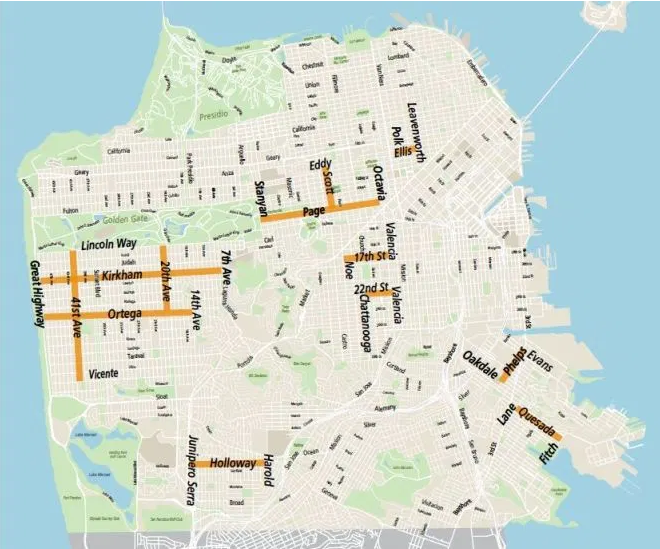Note: GJEL Accident Attorneys regularly sponsors coverage on Streetsblog San Francisco and Streetsblog California. Unless noted in the story, GJEL Accident Attorneys is not consulted for the content or editorial direction of the sponsored content.
San Francisco will start closing sections of twelve streets around the city to through traffic, in an effort to create more space for people to get out and exercise while practicing safe physical distancing during the COVID-19 shelter-in-place order. The first closures will begin this week.
“As a result of this pandemic, our transportation system has had to undergo major changes that have affected the way many of our residents get around the City,” said Mayor London Breed in an announcement this morning about the new program. “While traffic congestion has dropped, it is still difficult for people to maintain physical distance on many sidewalks. The most important thing that people can do right now is to remain inside as much as possible. But when they do have to go outside for essential trips, this program will help people keep six feet of distance from others.”
The twelve streets that were chosen, as seen in the map above and the chart below, are intended to "provide a network of streets that prioritize walking and biking for essential trips while still allowing local vehicle traffic." That means people walking or running will be allowed to do so in the street, and local vehicles will be allowed to drive and park there. The city plans to phase in the changes at a rate of two or three streets per week.
These streets were chosen because they don't interfere with Muni's remaining core bus routes. They could also help facilitate biking along bus routes that have been temporarily discontinued.
“Our agency is committed to giving San Franciscans the necessary space to practice social distancing as they leave their homes for critical needs,” said Jeffrey Tumlin, SFMTA Director of Transportation, in the announcement. “The purpose of Slow Streets is to accomplish those goals while managing traffic speeds and creating a safe network for essential walk and bike travel while transit service levels are reduced.”
“Slow Streets is a creative way to support pedestrian safety, physical activity, and social distancing,” said Dr. Grant Colfax, San Francisco Director of Public Health. However, Colfax reminded citizens, it is still important to stay home whenever possible and to maintain that six feet of distance from others. (Note from Streetsblog: is this really a 'creative' solution? Maybe. But opening streets to people under pressure from the pandemic is really just partially undoing the made-up crime of "jay walking.")
"We’re grateful that Mayor Breed took this important step forward to start creating safe space for walking. But this approach must be quickly expanded. We need a true network of safe streets for people to be able to walk to essential destinations," wrote Walk San Francisco's Jodie Medeiros, in an email to Streetsblog.
Meanwhile, this move follows earlier developments in Oakland to create a network of 'slow streets,' where through traffic is banned and walking in the street is permitted. Other cities in the Bay Area, including San Mateo, which is considering closing five neighborhood streets, have developed or are developing similar programs.
For more information on San Francisco's slow streets policy, check out the SFMTA website.






